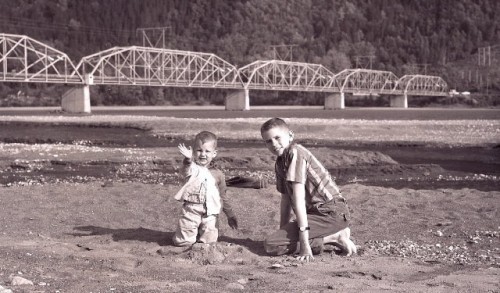
Sitka School Board members Jen Robinson, Tim Fulton, Lon Garrison, Cass Pook, superintendent Mary Wegner, and Tonia Rioux take a dunking for ALS. In turn, the board challenged the Kodiak school board, former Sitka superintendent Steve Bradshaw, and the Sitka Native Education Program. (KCAW photo/Robert Woolsey)
2014 in Sitka will be remembered for water: Water piling up behind a brand new dam, the most expensive project in Sitka’s history; water falling from the sky that brought down a mountainside, made a major highway construction project nearly impassable, and tested the limits of a high-tech temporary filtration system. And if that wasn’t enough, there was something about ice buckets.
Here’s a look back at our wet, weird year.

The Blue Lake Dam, as it looked in September, 2014. Work finished ahead of schedule, and, thanks to heavy rains, the plant began providing Sitka with power almost immediately.
Although there were several public tours during construction, most Sitkans probably don’t appreciate the size of the Blue Lake hydro expansion — and won’t, until they drive up there next spring and see it for themselves.
Contractors erected the largest construction crane in the state to span the gorge, and raised the existing Blue Lake dam 83 feet — literally building a huge, new dam on top of the old.

Representatives from McMillen LLC, Barnard Construction, and the city cut the ribbon, including (l to r) Andrew Pharis, Dean Orbison, Mim McConnell, Mark Gorman, and Jessica Stockel (Emily Kwong/KCAW photo).
Project engineer Dean Orbison came out of retirement to oversee the two-year endeavor. At the November ribbon cutting, his over-the-top enthusiasm was infectious as ever.
Now that this plant is expanded and it’s bigger, and it’s higher, we can make more electricity from the Blue Lake plant than we can from Green Lake.
For consumers, the project had little direct impact on our lives — except maybe on our taste buds and our scalps. Budgeted into the $157-million for Blue Lake was a temporary filtration plant on the Indian River, to supply Sitka with water during the final stage of construction. While a technological marvel, the plant produced water with a bit more chlorine than the town was used to, and there were plenty of complaints about taste and dry skin. The large numbers of spawning and dying pink salmon in the river didn’t contribute to the water’s appeal. But once the new penstock was installed, the $4-million plant rolled away almost overnight, and Sitka was again awash in some of the best water anywhere.
But awash isn’t always a good thing. Heavy rains in August delayed construction of Halibut Point Road into September. The exposed roadbed wasn’t up to the deluge, and traffic was brought to a near-standstill by the ruts.

The main area of the slide encompasses an area of roughly 100 acres. (USFS photo)
Yet, things could have been worse.
And it wasn’t until we actually climbed through the initial front of the slide that we saw the magnitude of it.
That’s Forest Service hydrologist Marty Becker talking about a 100-acre slide in the Starrigavan Valley. If this slide had occurred anywhere involving human habitation, it might have ranked as an epic disaster. Yet, like the Blue Lake Dam, most people have not seen it.
Over history, we have had our share of human disaster. In March, Sitkans — along with the rest of the state — reflected on the 50th anniversary of the Good Friday Earthquake, the largest earthquake in North America, and the second-largest in recorded history.

Dennis Girardot (left) with his brother John Reitz (right) at the Knik River Bridge in Palmer. Girardot was five year old when he and his family survived the Great Alaska Earthquake of 1964. (Photo courtesy of Dennis Girardot).
KCAW produced a four-part series sharing some of these stories of Sitkans who experienced the quake — each tale more amazing than the last. This is Dennis Girardot.
My mother was in the kitchen preparing a pot of chili and this beautiful cake, birthday cake for my brother in a shape of a guitar. He was a Beatles wanna be at that time. I remember hearing her scream and the chili just went all over the kitchen. All over the cake. A door fell open to the closet and my brother’s presents birthday presents flew out of the closet so he got to see what he was going to get.
2014 was also the 40th anniversary of Porky Bickar’s legendary April Fools prank, the Eruption of Mt. Edgecumbe. Like the Great Quake, Porky’s story will be passed on indefinitely.
2014 was a year of big transitions in Sitka. Both school systems got new superintendents: J. Thayne at Mt. Edgecumbe, and Mary Wegner at Sitka High. Wegner was the first to make headlines, from a highly-placed shout-out this fall.

President Obama addresses educators at the ConnectED conference in Washington, DC.
President Obama – And then you’ve got Mary Wegner, the superintendent of the Sitka, Alaska, School District. Where’s Mary? She came a long way. There she is. Give her a hand for coming from Alaska….
When she was not receiving presidential accolades for adopting new technology, Wegner and the school district were dealing with a simmering gender-equity dispute over the use of Sitka’s new ballfield. Although an initial Title IX complaint was settled amicably, the federal Office of Civil Rights may have more work to do in Sitka next year.
In the Forest Service, Perry Edwards took over as District Ranger, the first biologist to hold that post in recent memory. Lawrence Spottedbird became the new General Manager of the Sitka Tribe of Alaska. Don Kluting passed on his carabiners to trooper Lance Ewers as head of Sitka’s fabled Mountain Rescue team.

David Mahaffey, the new Bishop of Sitka and Alaska at his installation ceremony in Sitka. (KCAW photo/Emily Forman)
And in October, Jeff Comer took the job as CEO of Sitka Community Hospital, and quickly recognized that he had inherited an organization in critical condition. Comer appealed to the assembly for $1-million in life support at its last meeting. The future of Sitka’s local hospital, however, may be a bigger story in 2015.
On a more spiritual note, the Orthodox Diocese of Alaska got a new bishop. Fr. David Mahaffey was invested in a ceremony last February at St. Michael’s Cathedral.
“A bishop is to be a papa. And that’s what he brings to us. Someone who loves us.”

Lt. Lance Leone, right, hugs Darryl Penn, a La Push resident who helped rescue him from a helicopter crash. Leone visited La Push at the fourth anniversary of the July 7, 2010 crash. (Photo: Ed Ronco/KPLU)
Some transitions in Sitka this past year fall squarely into either triumph or loss. Coast Guard helicopter pilot Lance Leone survived a 2010 crash that killed his commander and two crewmates; this summer he revisited the scene outside La Push, Washington, to thank his rescuers, and then quietly prepared to leave the service after being permanently denied promotion.
Listen to an investigative report about the crash of Air Station Sitka helicopter 6017 and how it — and other high-profile accidents — have affected accountability in the Coast Guard.

David Wilcox (l.), Brett Wilcox, Olivia Wilcox, and Kris Wilcox are greeted on the boardwalk in Ocean City, NJ, as they wrap up their 6-month, 3,000 mile run. (RunningTheCountry.com photo)
Meanwhile, the father-son team of Brett and David Wilcox were attempting to run across the country to raise awareness about genetically-modified food labeling. They made it, averaging around 20 miles a day for six months supported by mom Kris and sister Olivia. The entire Wilcox family team arrived in Ocean City, New Jersey, on July 19.

Heidi Horner Raffaele fills out the application. She and Karla traded traditional Irish wedding rings — called Claddagh rings — depicting a crowned heart cupped in a pair of hands. (KCAW photo/Emily Kwong)
In October, a federal judge struck down Alaska’s same-sex marriage ban. Teachers Heidi Raffaele and Karla Horner went to the Sitka courthouse the next morning to tie the knot, but learned that their legal marriage in California in 2008 was now recognized. Raffaele says their long partnership got off to a slow start.
Yeah. She did not notice me in the least. But it’s been kismet ever since. 19 years.
There was more joy in Sitka when the Wolves took the state high school baseball championship, during a home-field deluge in June. Later in the fall, the Mt. Edgecumbe Lady Braves took the state 3A volleyball title, in a warm, dry gym.

Kettleson’s collection of Alaskana, and the C.L. Andrews collection, are right at home in Stratton. (KCAW photo/Robert Woolsey)
And speaking of warm and dry, Sitka’s Kettleson Library up and moved in August, into temporary quarters in the former Stratton Library. Stratton had been buttoned up since the closure of the Sheldon Jackson College in 2007. The Kettleson move returned more than just heat and electricity to the now state-owned building, according to librarian Brooke Schafer.
That’s kind of the soul of the library, of this place. It’s not that there are books here, but there are people who have come here to spend time thinking and reading and being together quietly in this space.
There were tough times, too. In May, Sitka endured the week-long trial of Joe Robidou. The former middle school principal was acquitted of sexual assault, but his defense painted an unflattering portrait of the social and professional culture of Blatchley that Sitkans may find difficult to forget, much less to forgive.

The Sitka Assembly prepares to be doused in the Ice Bucket Challenge (KCAW photo/Rachel Waldholz)
And can you ever forgive someone who pours a bucket of ice over your head? Many Sitkans explored that question, as ALS insanity swept through the community, including the assembly, who then challenged the school board.
Lon Garrison – One, two, three! (Lots of screaming.)
As weird as it was, the viral phenomenon raised over $90-million for research into Lou Gehrig’s Disease — the most successful fundraiser in the history of the ALS Foundation, and possibly in the history of all non-profits ever.

Uncommonly good journalism: The Daily Sitka Sentinel is independently owned and published by Sandy and Thad Poulson. (KCAW photo/Robert Woolsey)
And finally, the story behind Sitka’s stories: The Daily Sitka Sentinel turned 75 years old in 2014. The fact that you pick it up every day is a testament to its solid, intelligent writing; its profound editorials; and its often-breathtaking photos. We’re all aware that much of what passes for media now is an attempt just to get our attention, however briefly. That this little newspaper after 75 years surges ahead on principles of thorough, ethical journalism really is big news.































